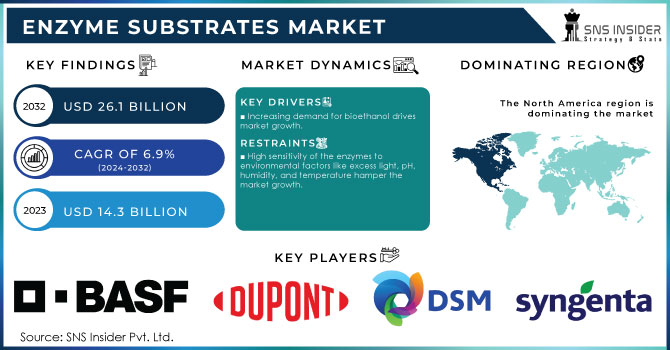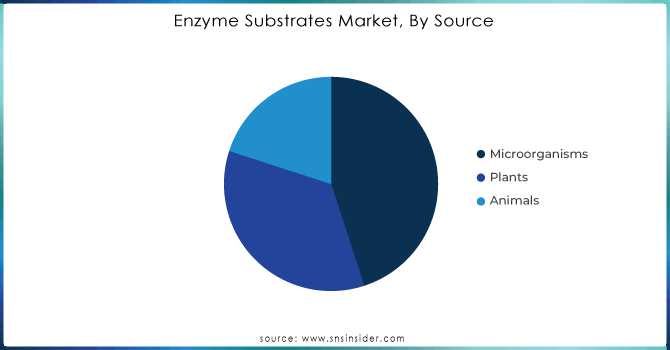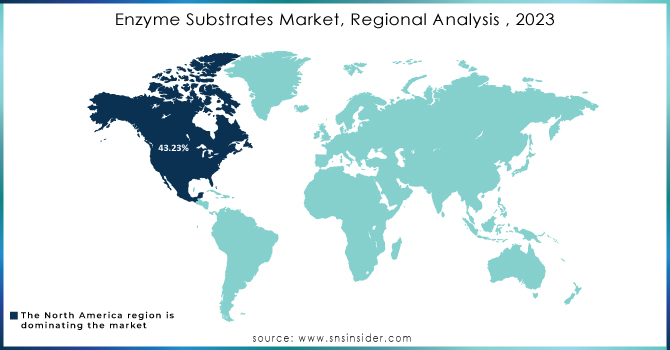Enzyme Substrates Market Report Scope & Overview:
The Enzyme Substrates Market Size was valued at USD 14.3 Billion in 2023 and is expected to reach USD 26.1 Billion by 2032 and grow at a CAGR of 6.9% over the forecast period 2024-2032.

Get more information on Enzyme Substrates Market - Request Sample Report
The biotechnology and pharmaceutical industries have been flourishing in recent years, and enzyme substrates are a key component of drug development, bio-processing, and diagnostics. This is critical in facilitating essential reactions for both pharmaceutical R&D and biotechnological operations. Moreover, the increasing trend toward personalized medicine where treatments are tailored to patient genetic profiles has definitely increased demand for enzyme substrates in diagnostics.
This trend has been further exemplified through recent moves by major players. For example, in 2022 Thermo Fisher Scientific expanded its enzyme substrate product line for next-generation sequencing (NGS) and molecular diagnostics to meet the demand for precision medicine. In 2023, Merck KGaA also unveiled novel enzyme substrates for bioprocessing applications and the ease in which they confirm the autosis of drug manufacturing with a higher degree of specificity and efficacy. Some of these advancements are a direct result of the increasing investments in pharmaceutical R&D and bioprocessing, which further propels innovation and demand for enzyme substrates.
An increasing number of sustainability and green chemistry initiatives has boosted the enzyme substrates market usage as multiple industries are identifying biocatalysts as a more environmentally compatible alternative to traditional chemical methods. A greener alternative, however, is the use of enzyme-based solutions that reduce chemical consumption and energy use across a wide range of applications. The need of Enzyme Substrates to increase the biodegradability alongside less pollution in sectors such as textiles, pulp and paper and waste treatment is gaining limelight.
Moreover, in the textile industry, goods are processed with enzymes instead of toxic chemicals, removing water and chemical waste. And that enzymes are used to reduce the amount of chlorine consumed in lignin bleaching in pulp and paper production, enabling a cleaner production process. The demand for enzyme substrates is also expected to increase with these sustainable practices lessening the impact on the environment as well as satisfying regulatory authorities and consumer preference, all of which has boosted the market.
In 2023, Novozymes, a leader in industrial enzymes, launched new enzyme solutions aimed at reducing energy and water consumption in textile processing.
Additionally, Innovations in enzyme engineering are enabling the development of more efficient and specific enzyme-substrate reactions. These advancements are boosting the adoption of enzyme substrates in industrial applications such as food and beverage processing, biofuel production, and environmental monitoring.
Enzyme Substrates Market Dynamics
Drivers
-
Increasing demand for bioethanol drives market growth.
This increasing growth of the demand for bioethanol a renewable and clean fuel, is a major contributor to the demands for enzyme substrates. Bioethanol is a type of renewable energy produced through the fermentation of sugars in crops e.g. corn and sugarcane, which use high enzyme substrates to metabolize the biomass into fermentable sugars. Amidst simultaneous global endeavours to decrease greenhouse gas emissions, bioethanol has become an attractive alternative of fuel if we consider transportation. This in turn will also drive a rise in demand for bioethanol blending with gasoline, further supported by global government policies.
For instance, in major bioethanol producing countries (e.g., United States and Brazil) the U.S. policy presents aggressive blending targets and hence would drive the market for enzyme-based solutions with very high efficiency to produce bioethanol. Enzyme Technology Enhancing Bioethanol Output along with Sustainability Playing a Central Role in Generating Opportunity for Enzyme Substrates Aforementioned all factor are expected to drive the growth of enzyme substrates market.
In 2022, BASF 2022, partnered with bioethanol producers to develop enzyme solutions targeting the pretreatment of lignocellulosic biomass. The company’s newly designed enzyme formulations improve the digestibility of plant materials, facilitating more efficient bioethanol production and further driving market growth.
Moreover, the efficiency of bioethanol production is heavily reliant on the performance of these enzymes, leading to increased demand for more advanced and specialized enzyme substrates. As countries and industries focus on reducing carbon emissions and promoting greener energy sources, the push for bioethanol has accelerated, with governments setting ambitious targets for ethanol blending in fuels. This trend is prompting continuous innovations in enzyme technologies to optimize bioethanol yields, reduce production costs, and make the process more sustainable, further contributing to the growth of the enzyme substrates market.
Restrain
-
High sensitivity of the enzymes to environmental factors like excess light, pH, humidity, and temperature hamper the market growth.
The high sensitivity of enzymes to a variety environmental factors, such as excess light, pH differences, humidity and temperature. Enzymes are specific biological catalysts, working under narrow environmental conditions. Alternations in these conditions may result in the denaturation or enzyme inactivation and, finally, decrease their capability to be used for bio-ethanol production, diagnostics and food industries. So, extreme conditions like too high and temperatures could denature the structure of the enzyme, and in a very opposite case it is the wrong pH level that could collapse some properties of the active from functioning to catalyze reactions. Simply high humidity or direct exposure to too much light can also mess with the enzyme activity over time.
Enzyme Substrates Market Segmentation
By Type
In 2023, Carbohydrase held the highest market share of 43.34% The carbohydrases, especially amylase, cellulase and lactase are the most significant industrial enzymes in food and beverages, bioethanol production and pharmaceuticals etc. For instance fermenting the fermentation enzymes are able to digest complex sugar molecules such as carbohydrates that is, for example, in brewing and baking or dairy factories need. In addition, carbohydrases have shown a significant growth in the market because of its application in converting starches and cellulose to fermentable sugars which is required for bioethanol. In a comprehensive analysis on enzyme substrates, considering the paramount role carbohydrase currently enjoys in the downstream processing units of energy & food industries because of its inherent flexibility, it trounces other enzymes types like proteases, lipases and polymerases.
By Source
Microorganisms market share is around 48.23% in 2023. Because of their efficiency and effectiveness, microorganisms are the key contributors to enzyme substrates in the market today followed by their range of applications, across different sectors. Another favoured source of enzymes is microorganisms such as bacteria, and fungi, because these organisms can be cultured in large scales and are genetically tractable to enhance specific enzyme activities. As most microorganisms are mesophilic, their enzymes are also meso-friendly, which means that these enzymes are more stable and can operate over a wide range of environmental conditions than the normal chemical and animal proteins used for industrial applications such as food processing, bioethanol production, pharmaceuticals, waste treatment.

Get Customized Report as per your Business Requirement - Request For Customized Report
By Reaction Type
The enzyme substrates market by type, the enzyme substrates market research report segments the industry in amylase, glucosidase, hydrolase as per enzyme. Hydrolases, enzymes that break down different chemical bonds by hydrolysis and are important in a catabolic process. In food and beverage, for instance, hydrolases are critical enzymes involved in processes like protein digestion or carbohydrate cleavage. These are essential in bioethanol production, where carbohydrases convert starches and celluloses to readily fermentable sugars. The hydrolases also found their dominance in the market is due to its wide applications and broad applicability in various sector whether it be pharmaceutical, agriculture or environmental management.
By Application
The enzyme substrates market is dominated by the food and beverage application segment. Food production enzymes function as essential agents that improve the quality and efficacy of food production, making it safer in the process. Amylase and protease additives in baking increase smoothness dough and texture of bread. Enzymes like alpha-amylase and beta-glucanase, work to break down starches into fermentable sugars that help the fermentation, making it more effective and contributing flavour. In cheese and yoghurt manufacture, enzymes help coagulate milk or separate whey. Growing demand for natural, clean-label ingredients in food and beverages is at the core of market expansion trends of enzyme applications.
Enzyme Substrates Market Regional Analysis
North America held the largest market share around 43.23% in 2023. North America has the largest growing enzyme substrates market. This is mainly driven by the region's strong industrial foundation, large investments into biotech and pharmaceutical research, as well as efficient technology infrastructure. Both the United States and Canada have sizeable sectors in food & beverage, bioenergy, pharmaceuticals (all high users of enzyme substrates for manufacturing/processing). North America also focuses on innovation and research and development in enzyme technologies, because the country has major companies with strong R & D that supports this segment. The existence of large industry participants like Novozymes, and DuPont also works to maintain the dominance of this region by contributing toward technology evolution, and opening doorways for new applications. Currently, focus on biotechnology and sustainability initiatives by majority of government institutions promotes North America as one the region leading from the front in enzyme substrates market and is expected to remain so during forecast period amalgamating both innovation and market growth.

Key players:
- Associated British Foods PLC
- DuPont (GENEN 2X, LpH)
- BASF SE (Lipex LDF, Optisol)
- AB Enzymes
- Koninklijke DSM N.V. (Maxam 2000, Enzomer)
- Syngenta (Agrisure and PowerCore, Enzyme Technologies)
- Advanced Enzyme Technologies Ltd
- Amano Enzyme Inc. (OptiBiotix, Pectinase)
- Codexis Inc.
- BioResource International Inc.
- Cargill Inc.
- Lesaffre
- Novozymes (Aquazym, Finizym)
- Naturex (Nutraflo Protease, Nutraflo Amylase)
- FMC Corporation (Enzyme Technologies, FMC BioPolymer)
- Haplogen GmbH (Haplogen Protease, Haplogen Amylase)
- Eli Lilly and Company (Lilly Protease, Lilly Amylase)
- Biocatalysts Ltd (Novozymes Lipozyme, Biocatalysts Protease)
- SAB Biotherapeutics (SAB™ Enzyme Systems, Bio-Gen)
- Tetra Pak (Tetra Enzymes Protease, Tetra Enzymes Lactase)
Recent Development:
-
In 2023, Novozymes launched Cellic CTec3, an advanced enzyme solution designed to enhance the efficiency of biomass conversion in bioethanol production. This new product improves the breakdown of lignocellulosic materials, offering higher yields and reduced processing costs.
-
In 2022, DSM launched Maxam 2000, a high-performance enzyme designed for animal feed applications. This product enhances the digestibility of feed ingredients, improving animal growth rates and feed efficiency.
-
In 2023, Syngenta released Agrisure Duracade enzyme technologies, which include advanced enzyme systems for enhancing crop protection and yield. These technologies are aimed at improving the efficiency of agricultural processes.
| Report Attributes | Details |
|---|---|
| Market Size in 2023 | US$ 14.3 Billion |
| Market Size by 2032 | US$ 26.1 Billion |
| CAGR | CAGR of 6.9% From 2024 to 2032 |
| Base Year | 2023 |
| Forecast Period | 2024-2032 |
| Historical Data | 2020-2022 |
| Report Scope & Coverage | Market Size, Segments Analysis, Competitive Landscape, Regional Analysis, DROC & SWOT Analysis, Forecast Outlook |
| Key Segments | • By Type (Protease, Carbohydrase, Lipase, Polymerase and Nuclease, Others) • By Source (Microorganisms, Plants, Animals) • By Reaction Type (Hydrolase, Oxidoreductase, Transferase, Lyase, Other) • By Application (Food and Beverages, Household Care, Bioenergy, Pharmaceutical and Biotechnology, Feed, Other) |
| Regional Analysis/Coverage | North America (US, Canada, Mexico), Europe (Eastern Europe [Poland, Romania, Hungary, Turkey, Rest of Eastern Europe] Western Europe] Germany, France, UK, Italy, Spain, Netherlands, Switzerland, Austria, Rest of Western Europe]), Asia Pacific (China, India, Japan, South Korea, Vietnam, Singapore, Australia, Rest of Asia Pacific), Middle East & Africa (Middle East [UAE, Egypt, Saudi Arabia, Qatar, Rest of Middle East], Africa [Nigeria, South Africa, Rest of Africa], Latin America (Brazil, Argentina, Colombia, Rest of Latin America) |
| Company Profiles | BASF SE, Associated British Foods PLC, Koninklijke DSM N.V., Advanced Enzyme Technologies Ltd, Amano Enzyme Inc., Codexis Inc., BioResource International Inc., Cargill Inc., Lesaffre, Chr. Hansen Holding A/S, Dyadic International Inc., Adisseo, Novozymes A/S, AB Enzymes, DowDuPont |
| Drivers | • Increasing demand for bioethanol drives the market growth. • Increase in environmental concerns. |
| Restraints | • High sensitivity of the enzymes to environmental factors like excess light, pH, humidity, and temperature hamper the market growth. |

